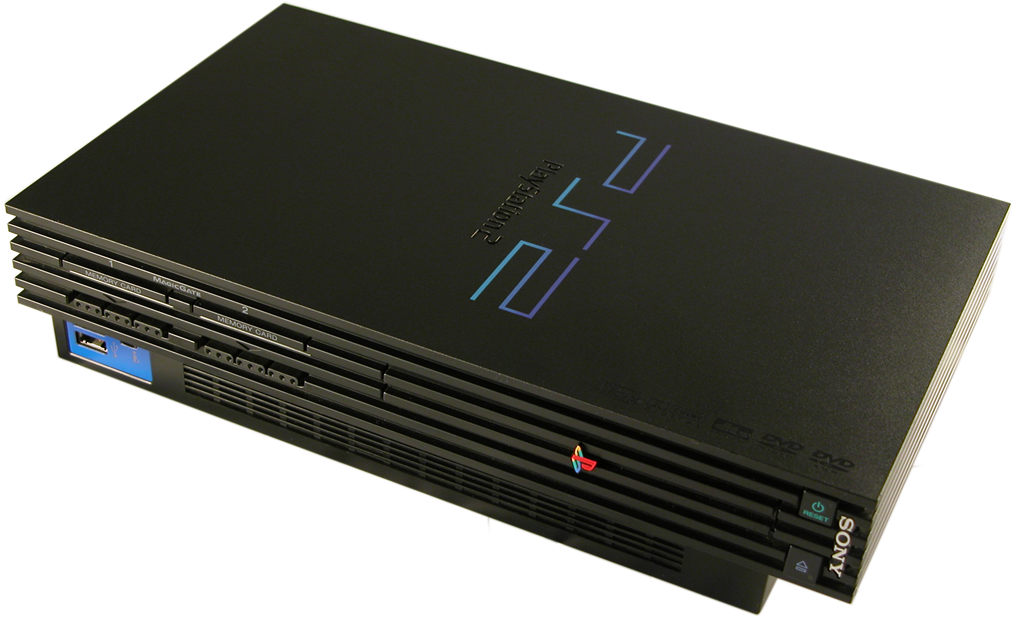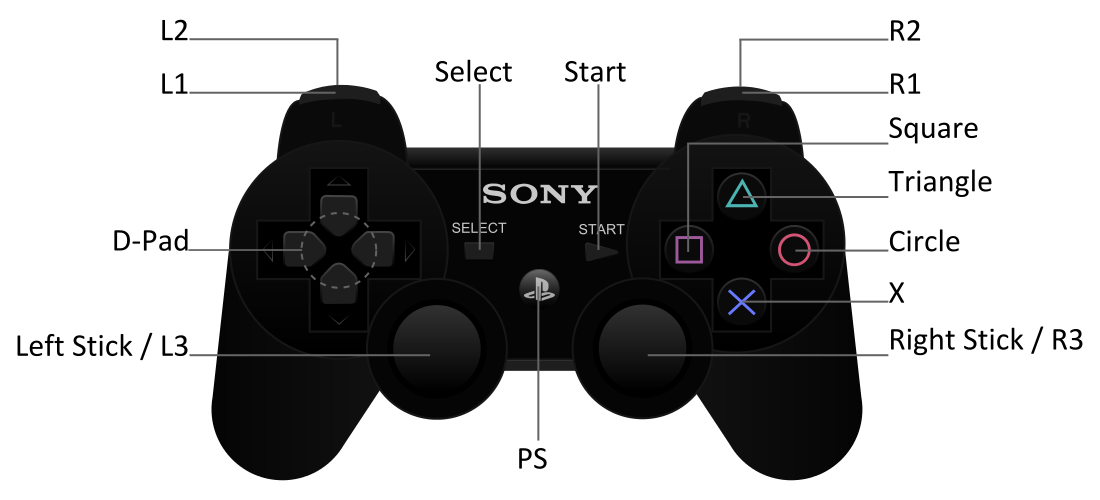Sony PlayStation 2

Technical Specifications
Emotion Engine
MIPS IV-subset
300 MHz (294.912 MHz)
128-bit integer SIMD
128-bit floating-point SIMD
24KB cache (16KB instruction + 8KB data)
16KB Scratch Pad RAM
Co-processor 1: FPU
Floating Point Multiply Accumulator (FMAC) x 1
Floating Point Divider (FDIV) x 1
8KB cache (4KB instruction + 4KB data)
Co-processor 2: VU0
Floating Point Multiply Accumulator (FMAC) x 4
Floating Point Divider (FDIV) x 1
8KB cache (4KB instruction + 4KB data)
Vector Processing Unit: VU1
Floating Point Multiply Accumulator (FMAC) x 5
Floating Point Divider (FDIV) x 2
32KB cache (16KB instruction + 16KB data)
450 Dhrystone 2.1 MIPS
6.2 GFLOPS
Geometry:
66 million polygons per second (peak)
38 million polygons per second (lighting)
36 million polygons per second (fog)
16 million polygons per second (curved surface generation)
Image Processing Unit (IPU): MPEG2 Compressed Image Decoder
150 million pixels per second
DMA: 10 channels
Graphics Synthesizer (GS)
150 MHz (147.456 MHz)
16 pixel pipelines
2.4 gigapixels per second (no texture)
1.2 gigatexels per second
Point, Bilinear, Trilinear, Anisotropic Mip-Map Filtering
Perspective-Correct Texture Mapping
Bump Mapping
Environment Mapping
32-bit Color (RGBA)
32-bit Z Buffer
4MB Multiported Embedded DRAM
38.4 gigabytes per second eDRAM bandwidth (19.2 GB/s in each direction)
9.6 gigabytes per second eDRAM texture bandwidth
150 million particles per second
Polygon Drawing Rate:
75 million polygons per second (small polygon)
50 million polygons per second (48-pixel quad with Z and Alpha)
30 million polygons per second (50-pixel triangle with Z and Alpha)
25 million polygons per second (48-pixel quad with Z, Alpha, and Texture)
18.75 million sprites per second (8 x 8 pixel sprites)
Emotion Engine to Graphics Synthesizer bus
64 bits wide
150 MHz
1.2 gigabytes per second bandwidth
Main Memory
32 Megabytes RAMBUS DRAM
32 bits wide (dual channel 16-bit)
400 MHz (800 MHz effective)
800 megabits per second per pin
3.2 gigabytes per second bandwidth
I/O Processor
based on PSone CPU
33.8688 MHz or 36.864 MHz (selectable)
2MB memory
USB, IEEE-1394, Sound, DVD-ROM, and PCMCIA controller
Sound Chip
48 voices
2MB memory
Supports Dolby, AC3, and DTS output
48 voices
2MB memory
Supports Dolby, AC3, and DTS output
Storage
General
4x DVD-ROM
DVD-5 disc format (4.7 gigabytes)
memory cards
Power
Power adapter : External
General
4x DVD-ROM
DVD-5 disc format (4.7 gigabytes)
memory cards
Power
Power adapter : External
Design
 |
| PS2 Design |
Console
The Ps2 boasts a geometric, slick design most commonly seen in black. The console can be placet both horizontal on on its back or standing upright, when it is upright it somewhat resembles a modern skyscraper. Almost all of the ports and buttons are situated on the front panel of the console. On the right side (horizontal) you have the power and eject buttons which are both light when in use. Moving left you have the disc tray which is adorned with the play station logo. The left side holds 4 ports, the top two are for the memory cards ad the bottom two are for the controllers. Under those you will find two usb ports that are used to connect peripherals such as the "Eye Toy" or light guns. The back panel has a port where you plug in the power adapter and a switch to turn on/off the console. This is rarely used due to the standby button at the front.
Controller
 |
| PS2 Controller |
The controller didn't change that much in design but most notable are the two analogue stick situated at the bottom. At the time they provided little to no use as games weren't centered around their mechanics.
 |
| Full Button list |
History
On march 1st, 1999 Sony had finally announced the PlayStation, this console was the first to be described as the competitor of Sega's Dreamcast which was the first 6th gen console to be released. Sony's announcement had little effect on the Dream cast as 500,000 units where sold within two weeks of the North American launch.
The PlayStation 2 was put on display at the Tokyo Game Show in September 1999, it came along with playable demos of upcoming games which wanted to show the capabilities of the consoles power and graphics, the demos included Tekken Tag tournament and Gran turismo 2000 which was later released as Gran Turismo 3: A-spec.
The official launch was in March 2000 in Japan, October in north America and November in Europe. The first day brought in 250$ million selling consoles ,games and accessories. This number the previous record holder of 97$ million by Dreamcast. Manufacturing delays caused severe shortages of the PS2, people started to find other alternatives to acquire this console. People started looking at auction websites such as eBay to get the latest console and some people payed over 1000$ for their console.
The PlayStation 2 was such a success that it Sega started to have problems. Financially and competitively thwarted Sega had announced the discontinue of the Dream-cast only 18 months after its initial release. This bode well for the PS2 as for 6 months it remained the only 6th gen concole. Competition gradually re entered the scene with the introduction of the Xbox and the Game Cube. the PlayStation 3 had the weakest specs out of all 3, the Xbox had the strongest hardware and the Game Cube having the lowest price. Needless to say the PS2 had a huge head start and was the only one to come with a DVD compatible disk drive, The Xbox needed an adapter and the GameCube had no compatibility at all. The PS2 2 1 upped the Xbox by securing exclusive rights to the games Grand Theft Auto and Metal Gear Solid 2 which where both highly wanted games at the time.
In May 2002 Sony cut the prices down from 299$ to 199$ in North America which made it the same price as the Game Cube further shattering its chances of success, It was also cut twice in Japan. These cuts where due to the anticipation of ht the PlayStation 3.
The PS2 went on to become the record holder of the most console to ever be sold in history, selling over 155 million units. 3,874 games where released since its launch and more then 1.5 billion sold.
The PlayStation 2 was put on display at the Tokyo Game Show in September 1999, it came along with playable demos of upcoming games which wanted to show the capabilities of the consoles power and graphics, the demos included Tekken Tag tournament and Gran turismo 2000 which was later released as Gran Turismo 3: A-spec.
The official launch was in March 2000 in Japan, October in north America and November in Europe. The first day brought in 250$ million selling consoles ,games and accessories. This number the previous record holder of 97$ million by Dreamcast. Manufacturing delays caused severe shortages of the PS2, people started to find other alternatives to acquire this console. People started looking at auction websites such as eBay to get the latest console and some people payed over 1000$ for their console.
The PlayStation 2 was such a success that it Sega started to have problems. Financially and competitively thwarted Sega had announced the discontinue of the Dream-cast only 18 months after its initial release. This bode well for the PS2 as for 6 months it remained the only 6th gen concole. Competition gradually re entered the scene with the introduction of the Xbox and the Game Cube. the PlayStation 3 had the weakest specs out of all 3, the Xbox had the strongest hardware and the Game Cube having the lowest price. Needless to say the PS2 had a huge head start and was the only one to come with a DVD compatible disk drive, The Xbox needed an adapter and the GameCube had no compatibility at all. The PS2 2 1 upped the Xbox by securing exclusive rights to the games Grand Theft Auto and Metal Gear Solid 2 which where both highly wanted games at the time.
In May 2002 Sony cut the prices down from 299$ to 199$ in North America which made it the same price as the Game Cube further shattering its chances of success, It was also cut twice in Japan. These cuts where due to the anticipation of ht the PlayStation 3.
The PS2 went on to become the record holder of the most console to ever be sold in history, selling over 155 million units. 3,874 games where released since its launch and more then 1.5 billion sold.
Evolution of the PlayStation 2
PlayStation 2 Commercials
The commercials where quite weird for my liking and some make little to no sense to me.
No comments:
Post a Comment